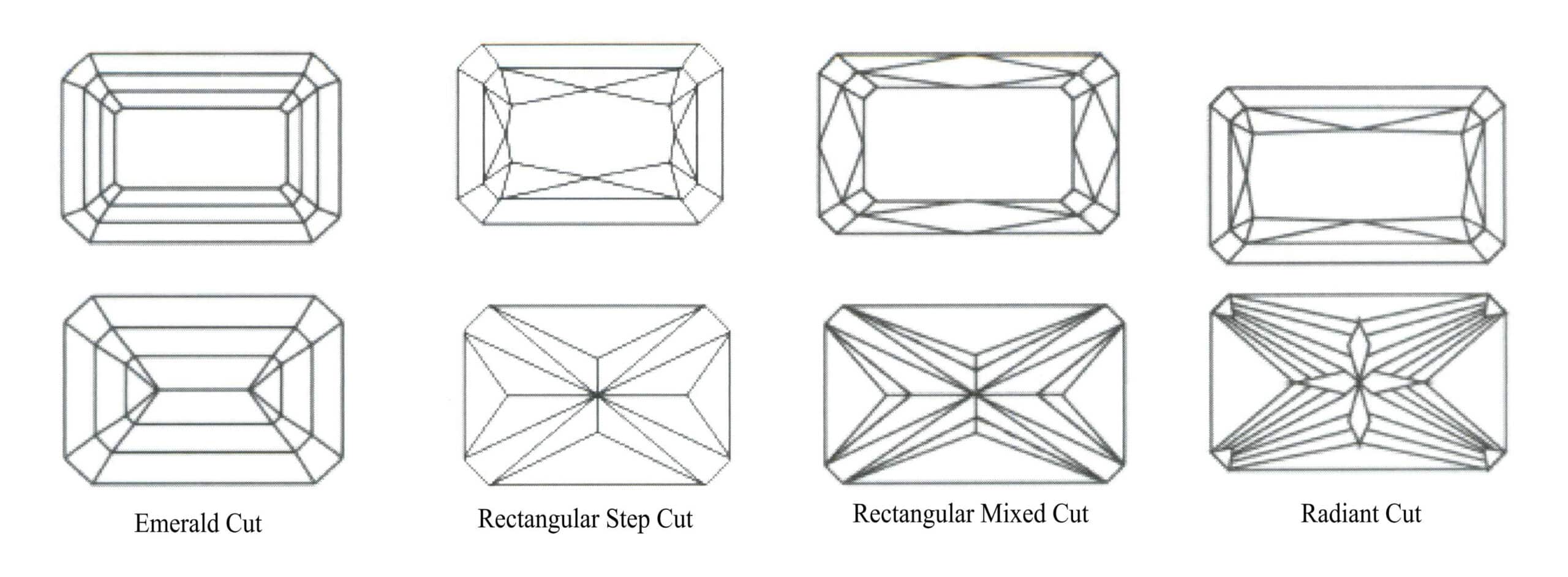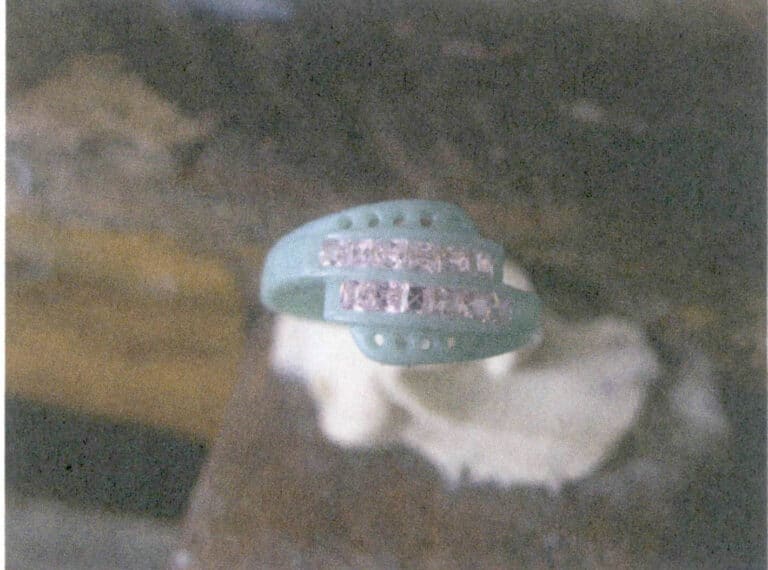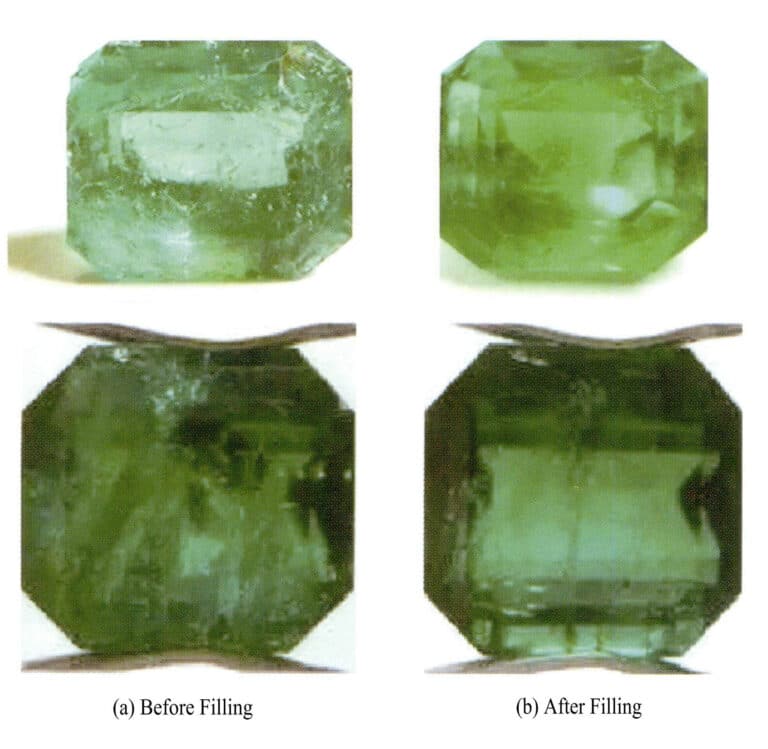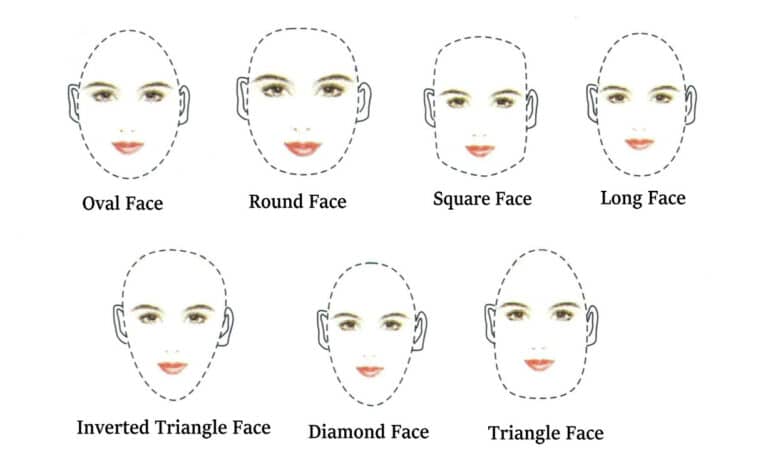How to do Gemstone Gemstone Cut Design?
Shaping, Drawing Techniques, and Proportions for Jewelers
Wprowadzenie:
This article provides a comprehensive guide to the basics of gemstone cutting design. It covers national drawing standards, the use of drafting tools, geometric drawing methods for gem design, common waistline drawing techniques in gem processing, angle and proportion design, and faceted gemstone cutting designs. Suitable for jewelers, designers, and anyone interested in the intricate art of gemstone shaping.

The effect of crown angle on gemstone fire
Spis treści
Section I Introduction to gem design
1. Graph lines in gem design
Table 2-3 Commonly used graph lines in gem design
| Nazwa | Line type | General Application |
|---|---|---|
| Thick solid line |
|
1. Visible contour line; 2. Visible transition line |
| Thin solid line |

|
1. Dimension line and dimension boundary line; 2. Section line; 3. Overlapping section contour line; 4. Leader line; 5. Boundary line and range line; 6. Bend line ;7 . Auxiliary line |
| Thin dashed line |

|
1. Invisible contour lines; 2. Invisible transition lines |
| Fine dotted lines |

|
1. Axis lines; 2. Symmetry center lines; 3. Trajectory lines; 4. Fillet circles and fillet lines |
| Fine double dotted lines |

|
1. Contour lines of adjacent auxiliary parts; 2. Contour lines of limit positions; 3. Contour lines of defective materials or contour lines of finished products in rough drawings; 4. Imaginary projection contour lines; 5. Interrupted lines |
| Wavy line (freehand continuous line) |

|
1. Boundary line at the break; 2. Boundary line between view and section in a local section view |
| Double broken line |

|
Boundary line at the break |
Note: The line length in the diagram is referred to as a point when it is ≤ 0.5 d.
2. Dimension Notation
(1) Basic Rules (Figure 2-4)
① The size of the gemstone should be based on the dimension values indicated in the drawing, regardless of the graphic’s size and the drawing’s accuracy.
② The dimensions in the drawing are generally in millimeters, and there is no need to indicate the unit of measurement’s code or name. Considering that jewelry pieces are relatively small and the aesthetic curves are difficult to dimension, dimensions may be omitted when drawing 1 : 1.
③ Each dimension of the gemstone should generally be indicated only once and marked on the graphic that best reflects that structure.
④The dimensions marked in the drawing are the final completed dimensions; otherwise, an additional explanation should be provided.

(2) Notation of linear dimensions
A complete linear dimension includes dimension boundary lines, dimension lines, and dimension numbers, as shown in Figure 2-4.
- Dimension boundary lines. Dimension boundary lines are drawn with thin solid lines and should be extended from the outline of the drawing, axis lines, or symmetry center lines.
- Dimension lines. Dimension lines indicate the length of the dimension and must be drawn separately with thin solid lines.
- Dimension numbers. Dimension numbers are generally written above the dimension line and can be written at the interruption of the dimension line.
3. Material of parts
Different material profile symbols are shown in Figure 2-5, and examples of drawings of beads of the same size but different materials are shown in Figure 2-6.


Section II The Use of Drawing Tools
Correctly using drawing tools can improve the quality and speed of drawing. Commonly used drawing tools for hand-drawn jewelry include drawing boards, T-squares, triangles, compasses, dividers, erasing boards, and gemstone templates.
1. Drawing Boards and T-Squares
The working surface of the drawing board should be flat, and the two guiding edges should be straight. The drawing paper can be fixed to the drawing board with tape, and the T-square is mainly used to draw horizontal lines, as shown in Figure 2-7. Common tools for gemstone design are shown in Figure 2-8.
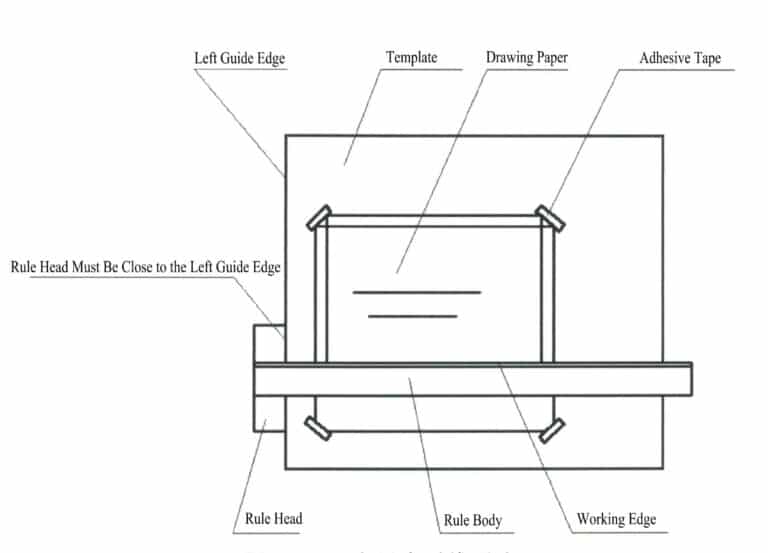

2. Triangle Ruler
It is used with a T-square to draw vertical lines, 30°, 45°, 60° various oblique lines, and parallel and vertical lines to a known straight line using the triangle ruler, as shown in Figure 2-9.
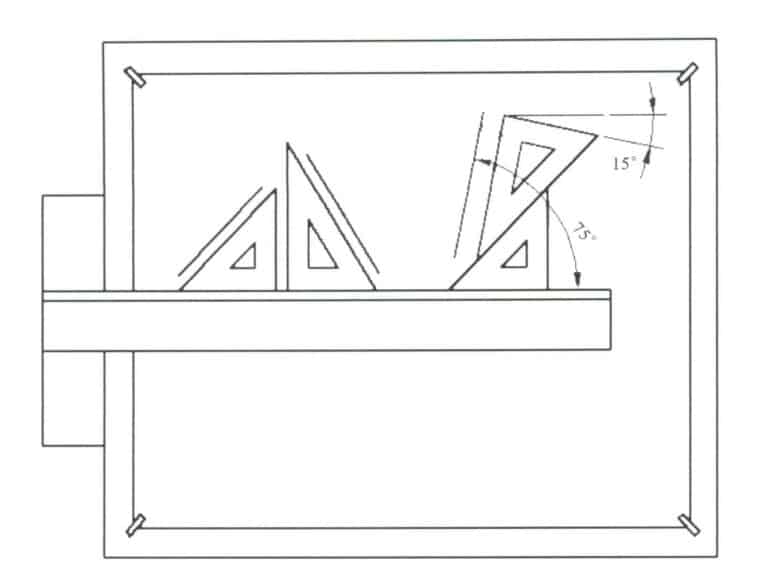
3. Drawing Instruments
Boxed drawing instruments come in sets of 3, 5, or 7 pieces. The most commonly used are dividers and compasses (Figure 2-10).
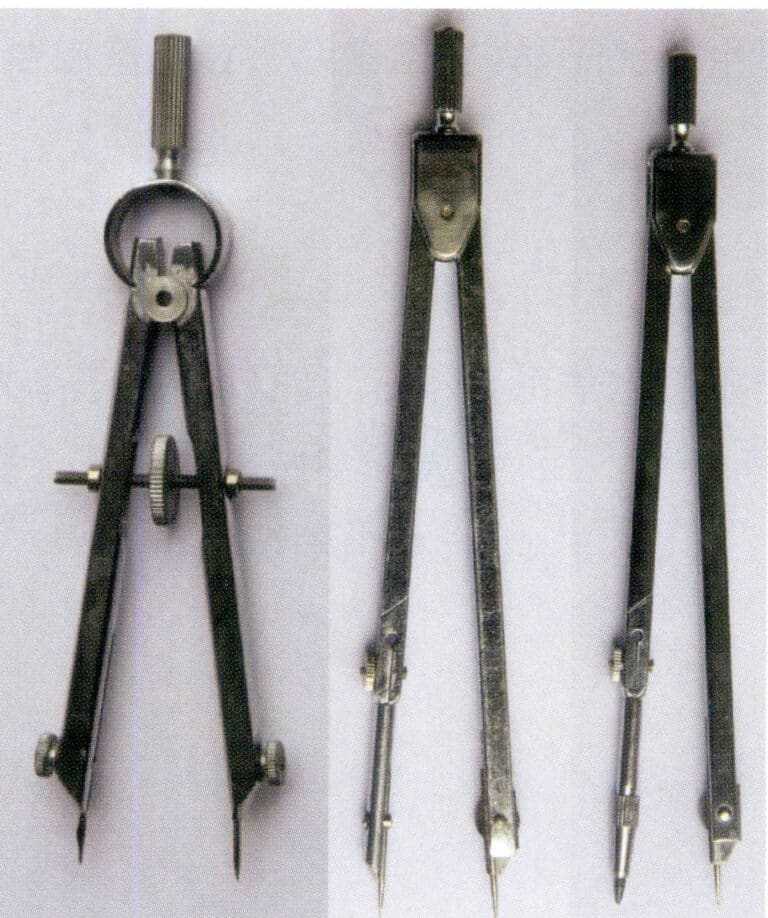
(1) Divider
A divider can divide line segments and measure dimensions from a ruler. It is the best measuring tool when drawing three views. There are two types of dividers; when the measured dimension is small and requires precision, it is best to use a spring divider.
(2) Compass
The steel points of a compass are divided into two different types; when drawing large circles or arcs, the end of the step should be used. If a large circle or arc is needed, an extension rod can be attached to the compass.
(3) Pencil
The hardness of the pencil lead is indicated by “B, H”: A larger number before “B” indicates a softer lead; a larger number before “H” indicates a harder lead. It is recommended to use “HB” or “B” for thick solid lines, “H” for fine solid lines, dotted lines, etc., and “HB” for writing and drawing arrows, as shown in Figure 2-11.

Section III Common Geometric Drawing Methods in Gem Design
Methods for dividing a circle (regular polygons), slope, cone angle, and plane curves are the foundation for drawing jewelry engineering diagrams and should be mastered proficiently.
1. Common Polygon Drawing Methods in Gem Design
Drawing method case 1:
Use a T-square and triangle to draw an inscribed or circumscribed regular hexagon, as shown in Figure 2-12.
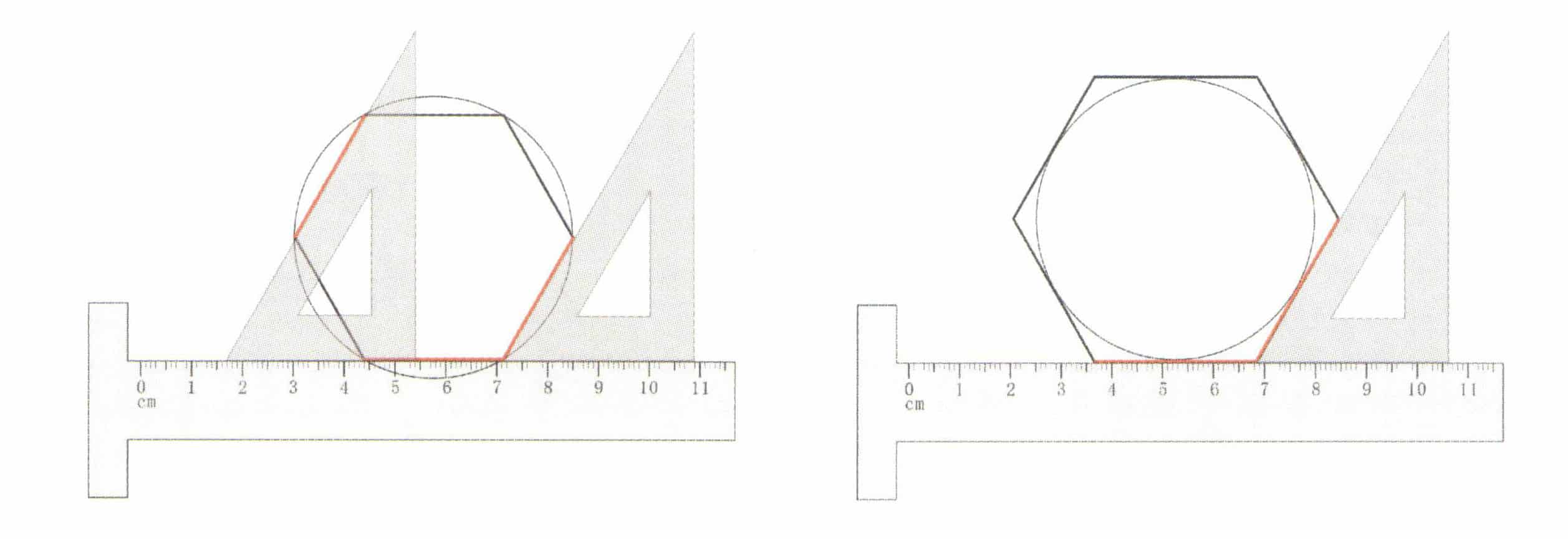
Drawing method case 2:
The method for drawing a regular heptagon, as shown in Figure 2-13.
- Draw the centerline intersecting at point O; use point O as the center and point A as the radius to draw a circle.
- Divide AN into 7 equal parts and label them with numbers.
- Draw an arc with point A as the center and AN as the radius, intersecting the centerline at point M.
- Connect M2 to the circumference at point B and connect M4 to the circumference at point C.
- AB=BC.
- Draw AB = BC = CD = DE = EF = FG = GA on the circumference.
- Connect the two adjacent points to form a heptagon.
- Erase the auxiliary lines to complete the drawing of a regular heptagon.

Heptagon Gem Design Instructional Video
2. Polygon Gem Design Cases
Design Case 1:
Triangle Gem Cutting Design Case, as shown in Figure 2-14.
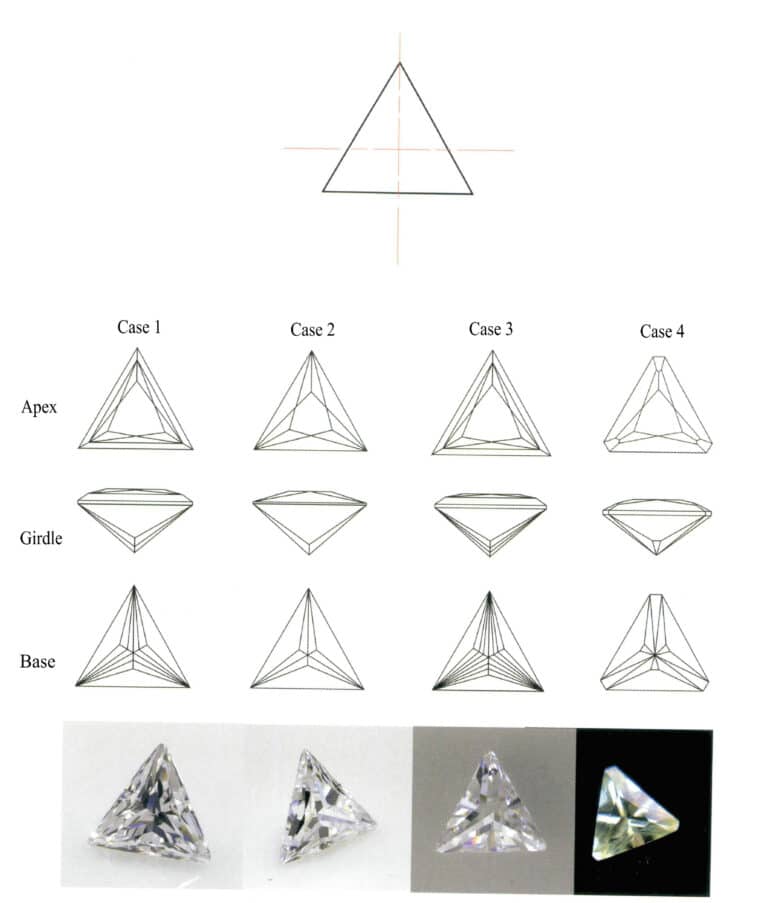
Design Case 2:
Fat Triangle Gem Cutting Design Case, as Figure 2-15 shows.
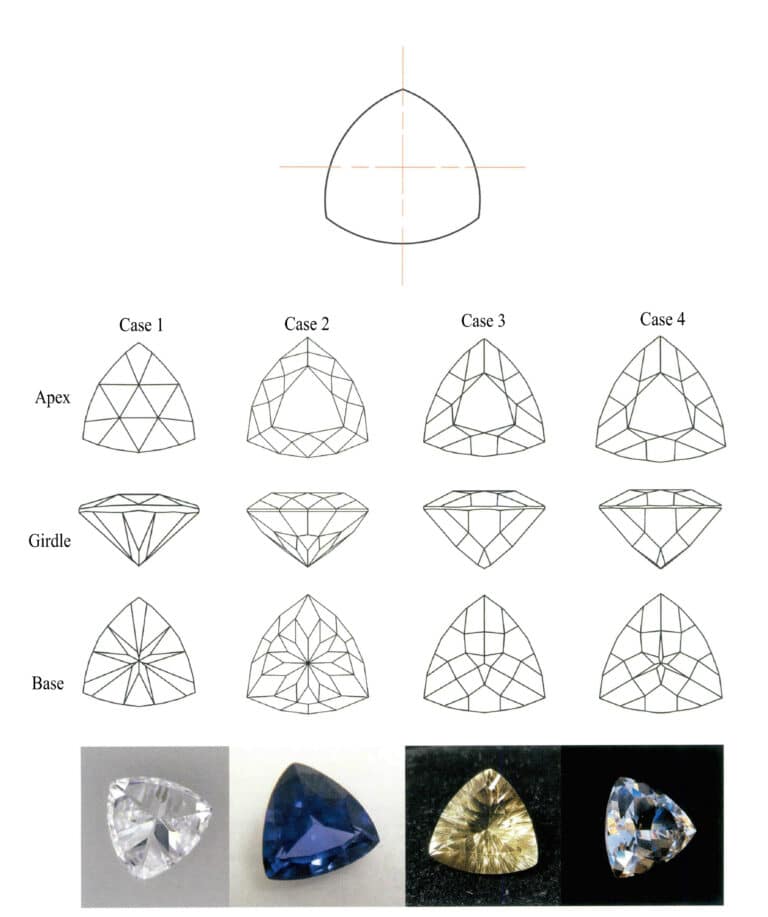
Design Case 3:
Princess Gem Cutting Design Case, as Figure 2-16 shows.

Design Case 4:
Pentagonal Gemstone Cutting Design Case, as shown in Figure 2-17.
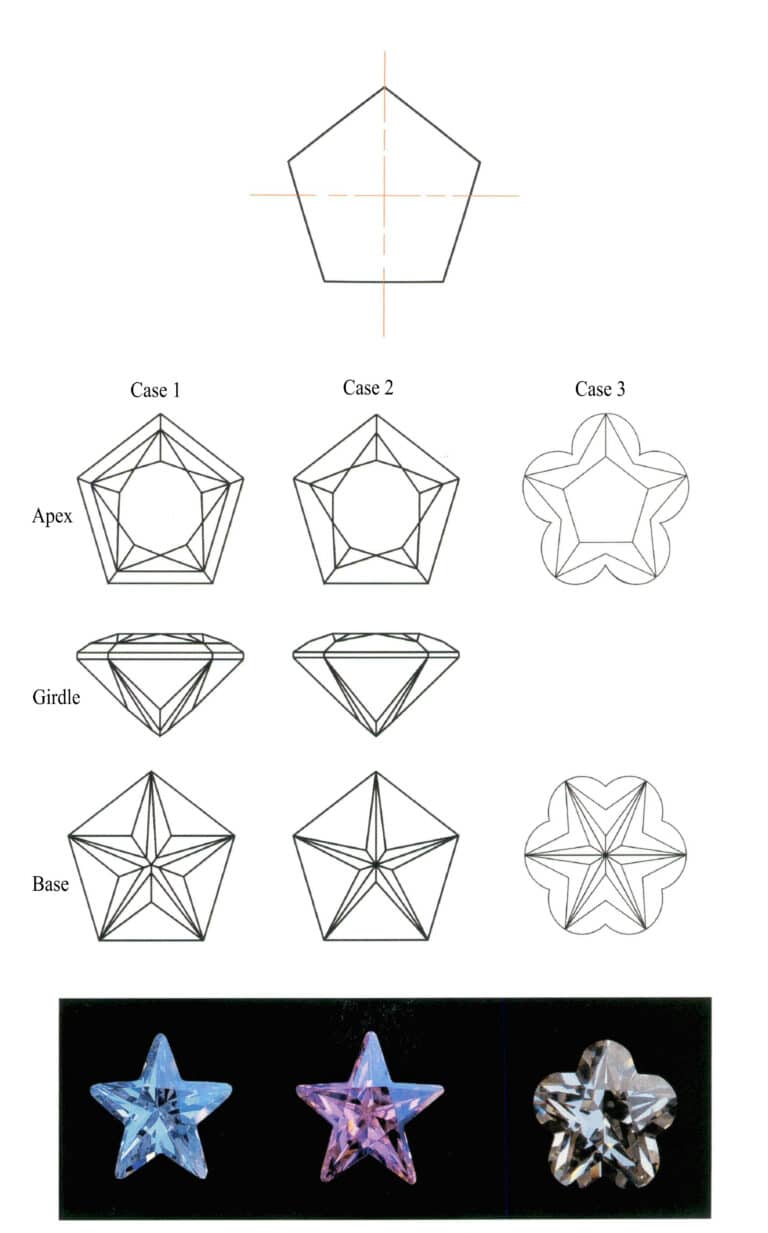
Design Case 5:
Hexagonal Gemstone Cutting Design Case, as shown in Figure 2-18.

Design Case 6:
Octagonal Gemstone Cutting Design Case, as shown in Figure 2-19.
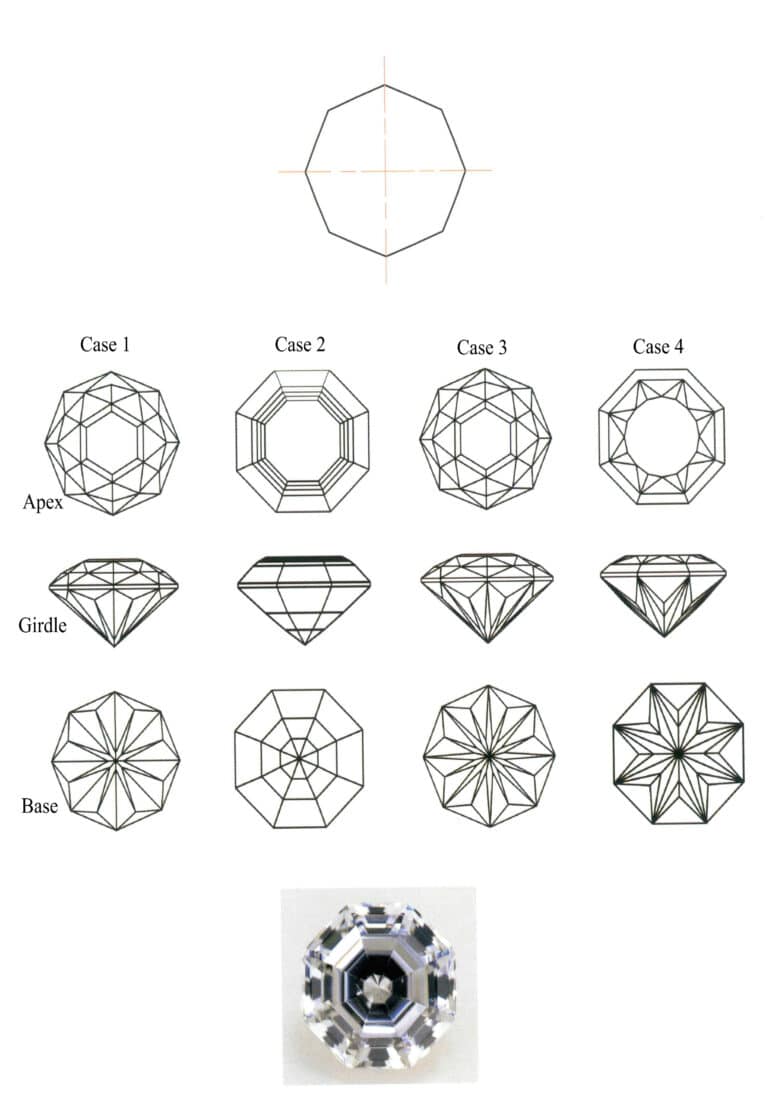
Section IV Common Waistline Drawing Methods in Gem Processing
1. Oval (Egg) Hand Drawing Method (Four Heart Circle Drawing Method)
Drawing Case 1: 35 mm x 50 mm The steps for the oval drawing method are shown in Figure 2-20.
- Draw the long axis AB = 50 mm and the short axis CD = 35 mm intersecting at point 0.
- Use point O as the center and draw an arc with radius AO that intersects the short axis CD at point E.
- Connect AC.
- Use point C as the center and draw an arc with radius CE intersecting AC at point F.
- Construct the perpendicular bisector of AF, which intersects the long axis at point 1 and the short axis at point 2.
- Find point 3 of point 1 on the long axis with point O as the center and the corresponding point 4 of point 2 on the short axis.
- Connect point 2, point 3, point 3, point 4, and point 1, point 4.
- With point 3 as the center and 3B as the radius, draw an arc.
- With point 1 as the center and 1A as the radius, draw an arc.
- Use point 2 as the center and 2C as the radius to draw an arc.
- Use point 4 as the center and 4。 as the radius to draw an arc.
- Erase the auxiliary lines and complete the drawing of the ellipse (egg) shape.
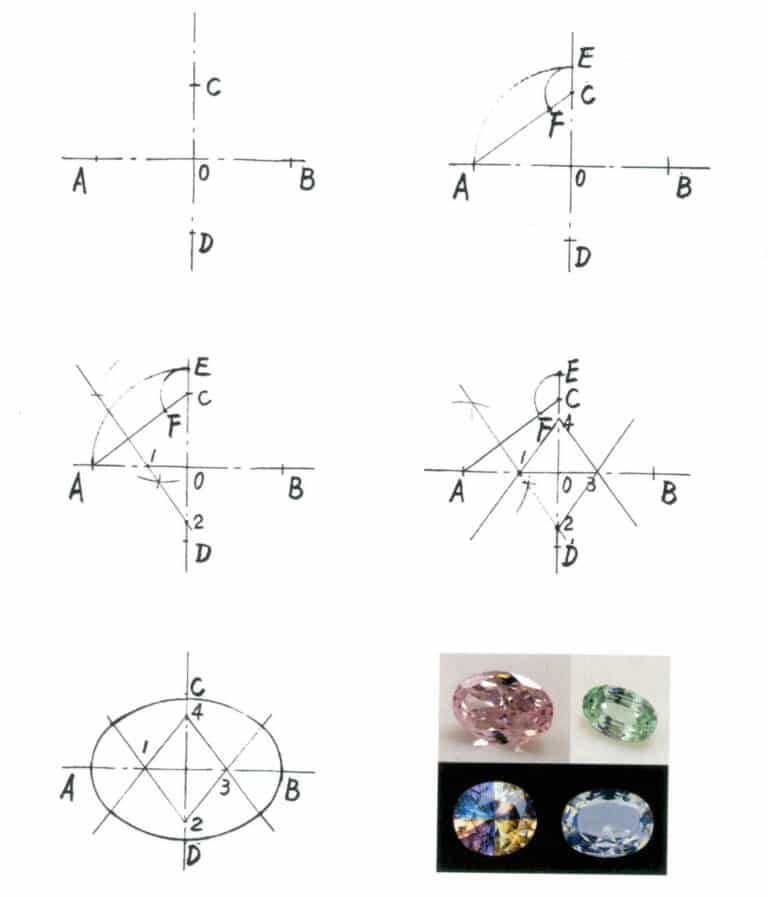
Oval (Egg-shaped) Gemstone Hand-Drawing Technique Tutorial Video
2. Hand-drawing method for the heart shape
Drawing example 2:30mm x30 mm The steps for drawing a heart shape are shown in Figure 2-21.
- Draw a square a×a with a side length of 30 mm, and draw the center line BB’.
- Take a point o on BB’ so that BO = 0.3a.
- Draw AA’ through point AC=A’C’=BO.
- Heart-shaped hand-drawing tutorial video.
- Draw a circle with point C as the center and AC as the radius.
- Draw a circle with point C’ as the center and A’C’ as the radius.
- Draw the perpendicular bisector of AB’ and intersect it with AA’ at point 2.
- Draw the perpendicular bisector of A’B’ and intersect it with AA’ at point 1.
- Draw an arc between A’B’ with point 1 as the center and l A’ as the radius.
- Draw an arc between AB’ with point 2 as the center and 2A as the radius.
- Erase the auxiliary lines to complete the heart shape drawing.
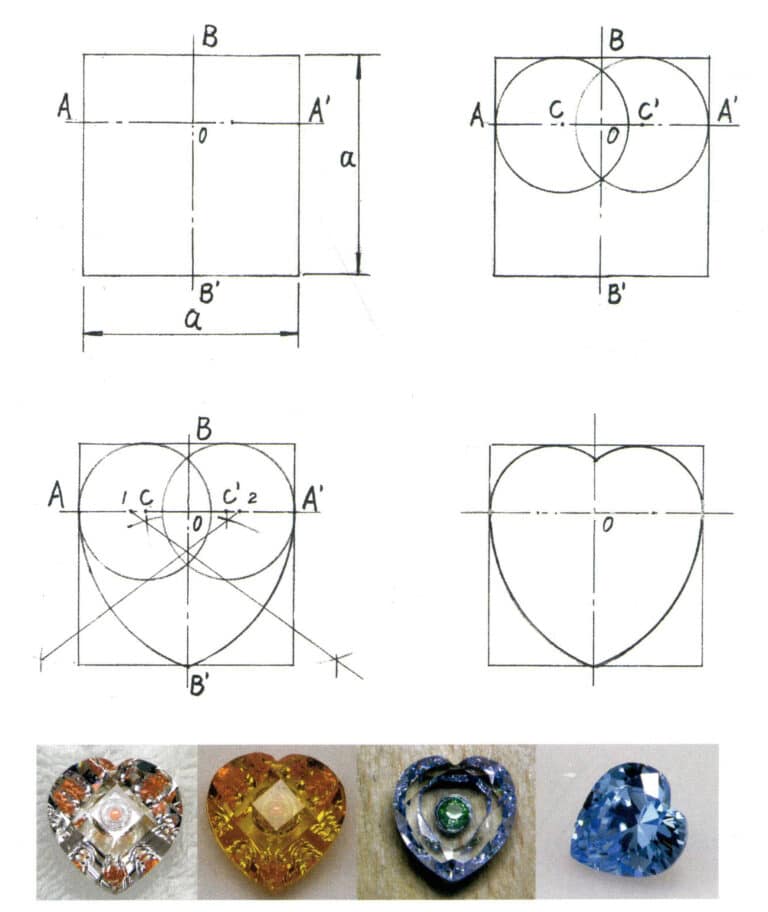
Heart-shaped Gemstone Freehand Drawing Instructional Video
3. Pear (teardrop) Shape Hand-Painting Method
Drawing Method Case 3: 30 mm x 50 mm Pear-shaped (water droplet shape) drawing steps diagram, as shown in Figure 2-22.
- Draw a rectangle 30 cm x 50 cm.
- Draw the center line of the rectangle’s width BB’.
- Take a point O on BB’, so OB = 0.5a.
- Draw a line through point O perpendicular to BB’ at AA’.
- Draw the perpendicular bisector of A’B’, which intersects AA’ at point C.
- The perpendicular bisector of AB’ intersects AA’ at point C’.
- Draw an arc between A’B’ with point C as the center and CA’ as the radius.
- Draw an arc between AB’ with point C’ as the center and C’A as the radius.
- Erase the auxiliary lines and complete the drawing of the pear (water droplet) shape.
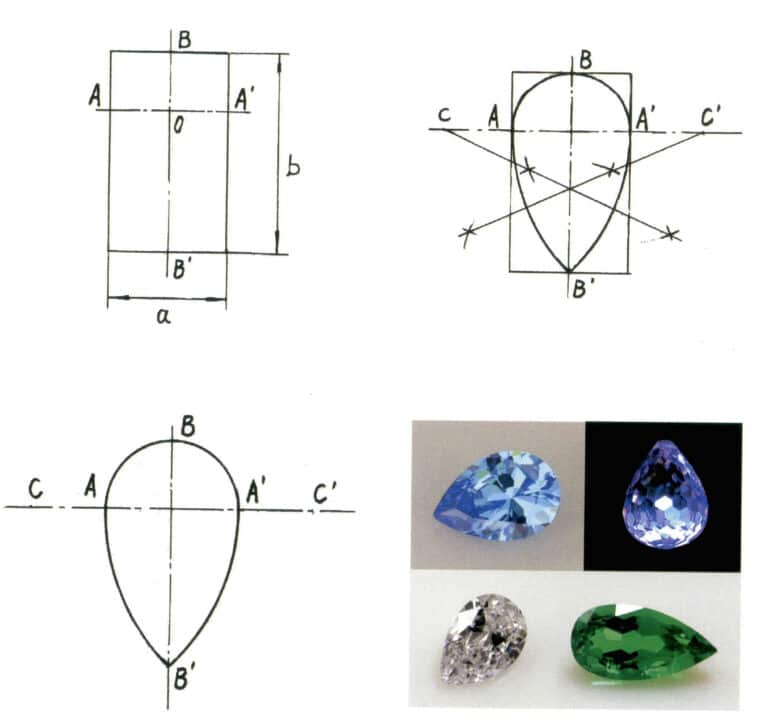
Pear (Teardrop) Gemstone Freehand Drawing Tutorial Video
4. Hand-drawing Method for Marquise Cut
Drawing Method Case 4: 30 mm×60mm The steps for drawing the Marquise Cut are shown in Figure 2-23.
- Draw a rectangle 30 mm × 60 mm.
- Draw the center line AA’, BB’ intersecting at point O.
- Draw the perpendicular bisector of A’B’ intersecting BB’ at point C .
- Use point O as the origin to draw OC = OC’.
- Use point C as the center and draw an arc through point A, B’, A’.
- Use point C’ as the center and draw an arc through point A, C, A’.
- Erase the auxiliary lines to complete the drawing of the eye shape.
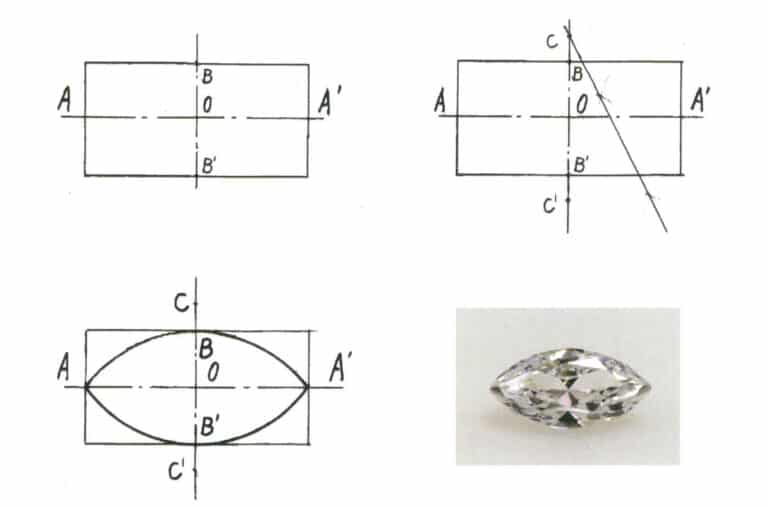
Marquise Gemstone Freehand Drawing Tutorial Video
5. Hand-drawing method for fat triangles
Drawing Method Case 5: The steps for drawing a fat triangle are shown in Figure 2-24.
- Draw an equilateral triangle.
- Draw auxiliary circles with the three vertices of the equilateral triangle as centers and the side length as the radius.
- Use the arc between two vertices of the equilateral triangle as the three arc sides of the fat triangle.
- Erase the excess auxiliary arc lines to complete the drawing of the fat triangle.

6. Hand-drawing method for Fat cushion shape
Drawing Case 6: The steps for drawing a Fat cushion shape are shown in Figure 2-25.
- Draw an auxiliary square and make two center lines intersect at point O.
- The center lines intersect the square’s four sides at 4 points.
- As shown in Figure 2-25, draw four auxiliary circles with 4 points as centers and a radius of R (R is the straight-line distance from the midpoint of one side of the auxiliary square to the endpoint of the opposite side).
- Take the arc between the two vertices of the square as the four arc edges of the Fat cushion
- Erase the excess auxiliary arc lines to complete the Fat cushion shape drawing.

Copywrite @ Sobling.Jewelry - Producent biżuterii na zamówienie, fabryka biżuterii OEM i ODM
7. Hand-drawing method of 6 petals and 5 petals flower shape
Drawing Method Case 7: The steps for drawing a hex apetalous are shown in Figure 2-26.
- Draw a helper circle with a diameter of A.
- Divide the helper circle into six equal parts and draw auxiliary lines.
- Take R = 0.2A to make 6 dots.
- To draw six small auxiliary circles, take R = 0.2 A as the radius on each auxiliary line.
- Erase the excess auxiliary arc lines to complete the hex apetalous

Drawing Method Case 8: The steps for hand-drawing a cinquefoil are shown in Figure 2-27.
- Draw a helper circle with a diameter of A.
- Divide the auxiliary circle into five equal parts and draw auxiliary lines.
- Take R = 0.24A to make five dots.
- On each auxiliary line, take R = 0.2A as the radius to draw five auxiliary small circles.
- Erase the excess auxiliary arc lines to complete the drawing of the cinquefoil shape.
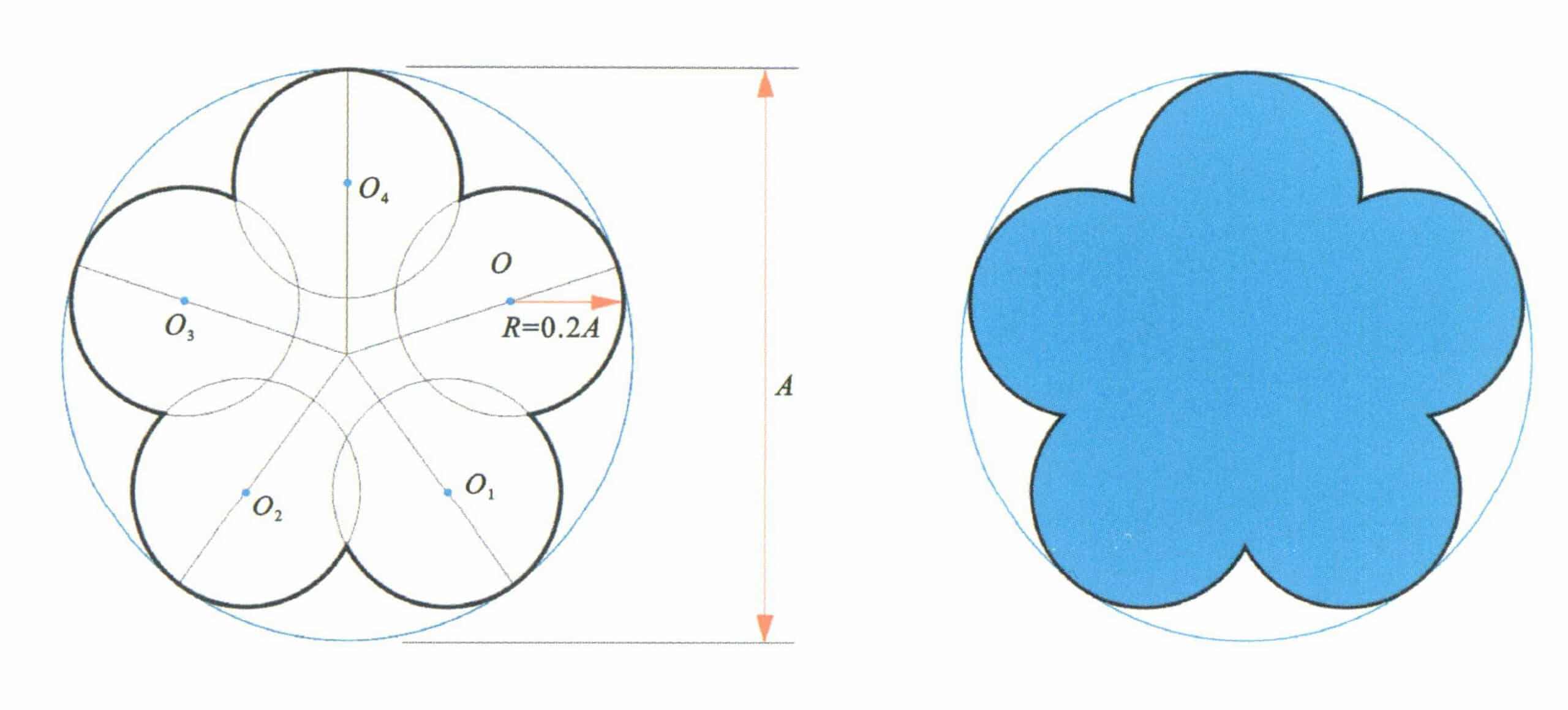
8. Hand-drawing methods for squares, rectangles, and trapezoids
(1) The hand-drawing methods for squares and rectangles are shown in Figure 2-28.

(2) The method of hand-drawing a ladder is shown in Figure 2-29.

9. Standard Round Brilliant Type Hand Drawing Method
(1) Names of Each Part of the Standard Round Brilliant Type (Figure 2-30)
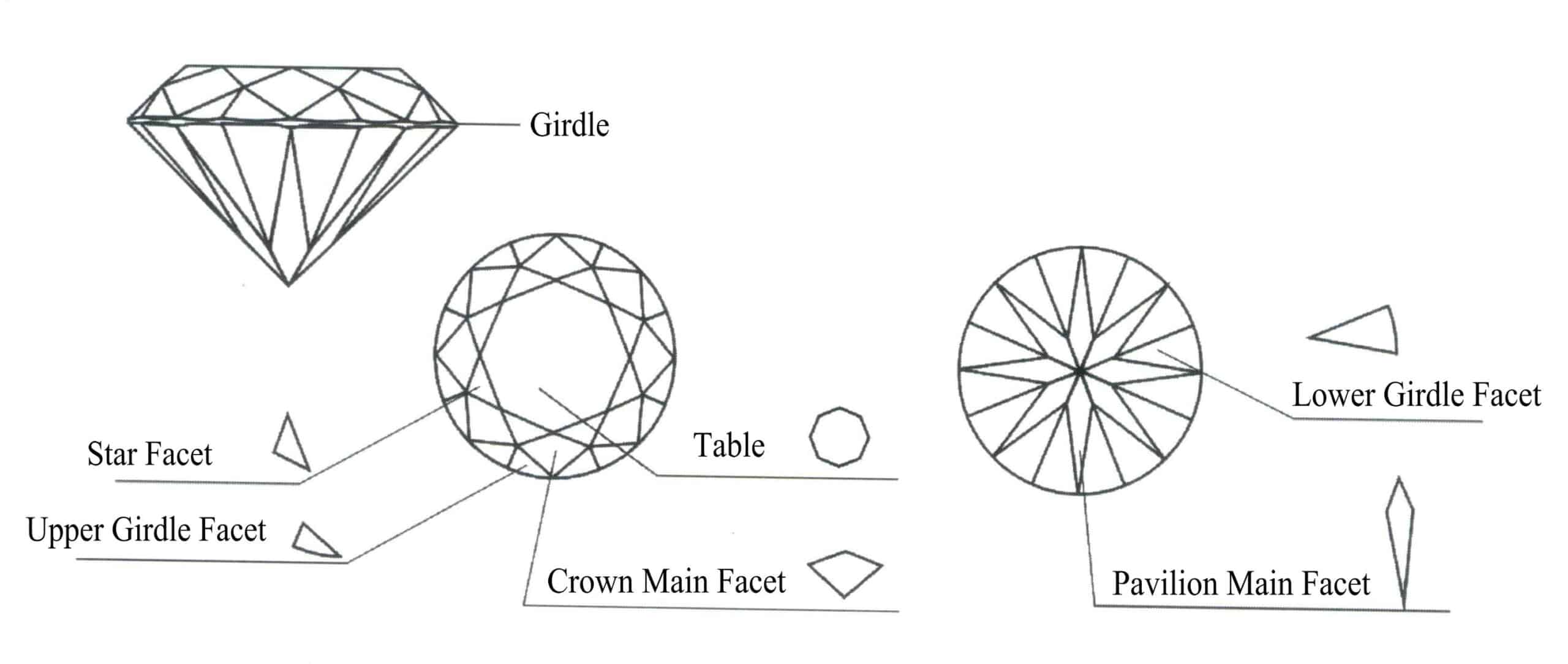
(2) Standard Round Brilliant Type Hand Drawing Method
Drawing Case 9: The steps for the standard round brilliant -type crown drawing are shown in Figure 2-31.
- Divide the circle into 16 equal parts (as shown in Figure 2-31, mark the numbers clockwise).
- At the odd division points, draw a line segment of length 3/16R (R is the radius) towards the circle’s center.
- In sequence, Connect the endpoints of the line segments towards the center of the circle at points 1, 5, 9, and 13.
- Connect the endpoints of the line segments towards the center of the circle at 3, 7, 11, 15 in sequence to form 2 squares, completing the drawing of the upper star-shaped surface in the top view.
- Connect the endpoints of the line segments in the 3/16R direction of the center of the circle with even points to complete the drawing of the lower waist small surface in the top view.
- Draw the side view directly below the top view, as shown in Figure 2-31, projecting to obtain the waist width, with the total height occupying 60% of the waist width, and the depth of the pavilion occupying 2/3 of the total height.
- Project the corresponding points of the crown top view onto the side view.
- Connect the points corresponding to the crown top view to complete the drawing of the crown side view.
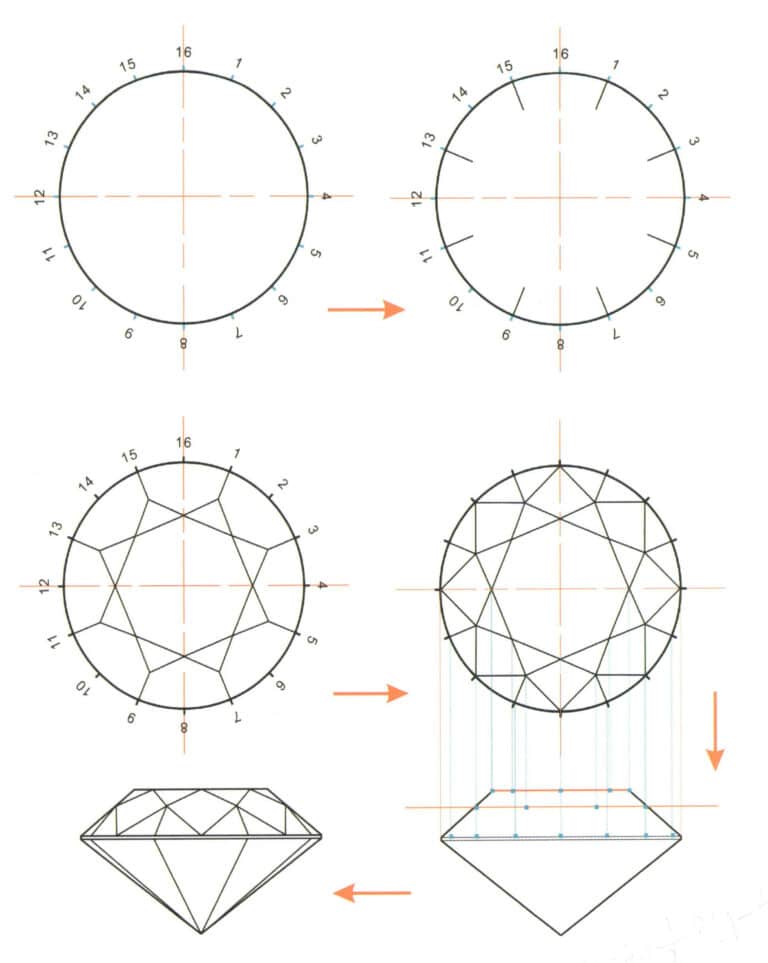
Drawing Case 10: The steps for drawing the standard round brilliant-type pavilion are shown in Figure 2-32.
- Draw a circle of equal size below the side view, dividing the circle into 16 equal parts (as shown in Figure 2-32, with clockwise numbers).
- Connect the odd points through the circle’s center to divide the circle into eight equal parts, completing the drawing of the lower waist surface in the top view.
- Draw a concentric auxiliary circle with a radius of 1/4R.
- Connect the eight equal points on the auxiliary circle with the even points on the outer circle to complete the drawing of the main facet of the pavilion in the top view.
- Project the corresponding points of the pavilion’s top view onto the upper side view.
- Connect the corresponding points of the pavilion’s top view to complete the drawing of the pavilion’s side view.
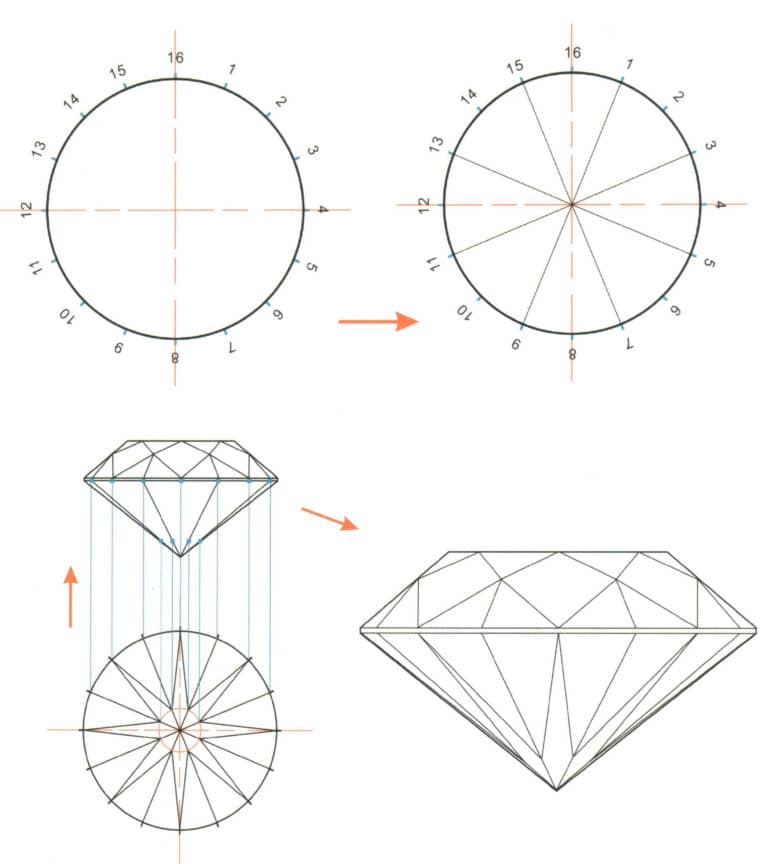
Standard Round Brilliant Gemstone Hand-Drawing Tutorial Video
10. Egg (oval) shaped carving hand-drawing method
Drawing case 11: The steps for egg (oval) shaped carving are shown in Figure 2-34.
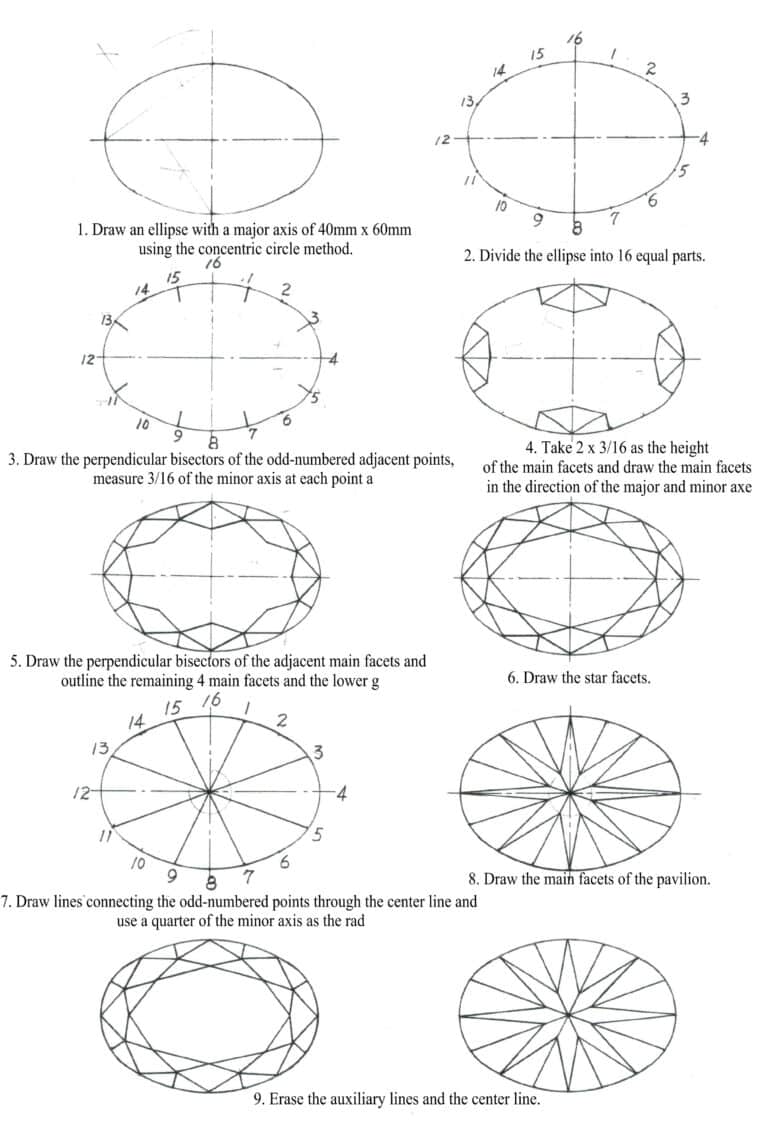
Oval (Egg-shaped) Gemstone Faceting Hand-Drawing Tutorial Video
11. Emerald-type manuscripts (Figure 2-35)

Emerald Cut Gemstone Hand-Drawing Tutorial Video
Common Gemstone Sizes in the Market (Table 2-4).
Table 2-4 Common Gemstone Size Table
Unit: mm
| Numer seryjny | Nazwa | Common Sizes |
|---|---|---|
| 1 | Standard Round Drill Bit | 0.8, 1.5, 2, 2.5, 3, 3.5, 4, 5, 6, 7, 8, 9, 10, 11, 12, 13, 15 |
| 2 | Oval | 1.5 x 3,2 x 4,3 x 5,4 x 6,5 x 7,6 x 8,7 x 9,8 x 10,9 x 11 |
| 3 | Heart-shaped | 2 x 2,3 x 3,4 x 4,5 x 5,6 x 6,7 x 7,8 x 8,9 x 9,10 x 10 |
| 4 | Pear (Teardrop) Shaped | 1.5 x 3,2 x 4,3 x 5,4 x 6,5 x 7,6 x 8,7 x 9,8 x 10,9 x 11 |
| 5 | Marquise Shaped | 1.5 x 3,2 x 4,2.5 x 5,3 x 6,4 x 8,5 x 10,6 x 12 |
| 6 | Emerald cut (with bevel or small octagon) | 1.5 x 3,2 x 4,3 x 5,4 x 6,5 x 7,6 x 8,7 x 9,8 x 10,9 x 11 |
| 7 | Kwadrat | 1.5 x 1.5,2 x 2,2.5 x 2.5,3 x 3,4 x 4,5 x 5,6 x 6,7 x 7,8 x 8,9 x 9,10 x 10 |
| 8 | Rectangular | 1 x 2,2 x 3,2 x 4,3 x 5,4 x 6,5 x 7,6 x 8,7 x 9,8 x 10,9 x 11,10 x 12 |
| 9 | Trapezoidal | 2 x 1.5 x 1,2.5 x 1.5 x 1,3 x 1.5 x 1,3.5 x 1.5 x 1,4 x 2 x 1,5 x 2.5 x 1 |
| 10 | Fat triangle | 2 x 2,3 x 3,4 x 4,5 x 5,6 x 6,7 x 7,8 x 8,9 x 9,10 x 10 |
| 11 | Zong (Baguette) shape | 2 x 2,3 x 3,4 x 4,5 x 5,6 x 6,7 x 7,8 x 8,9 x 9,10 x 10 |
| 12 | Baguette, cinquefoil | 4 x 4,5 x 5,6 x 6,7 x 7,8 x 8,9 x 9,10 x 10 |
Section V The Angles and Proportions of Gemstone Design
The special optical effects of faceted gemstones are mainly reflected in brightness and fire, which are also two factors humans can control.
1. Brightness
Brightness refers to the degree of brightness caused by light reflecting from the small facets on the underside of the gemstone.
The brightness of a gemstone is closely related to the total internal reflection of light, as shown in Figure 2-36.

The greater the refractive index, the smaller the critical angle. Light refracts from the crown of the gemstone into its interior. When the angle of incidence at the pavilion facet exceeds the critical angle for total internal reflection, and the angle of incidence at the crown facet is less than the critical angle, the light can maximally return from the crown of the gemstone, achieving the highest brightness. When the angle of the pavilion’s main facet (pavilion angle) is too large or too small, it causes light to refract out of the pavilion, resulting in light loss (Figure 2-37). When the angle of the crown’s main facet (crown angle) is too large, it causes total internal reflection at the crown, preventing light from refracting from the crown (Figure 2-38).
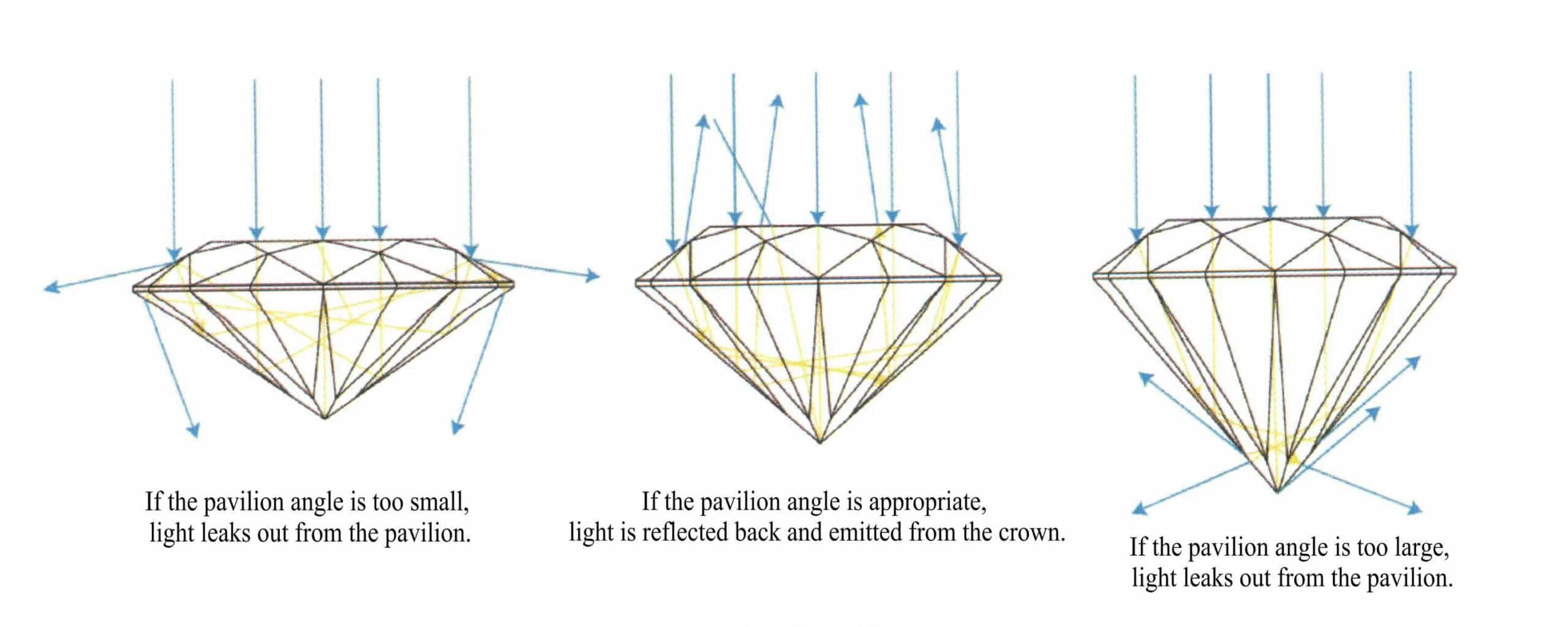
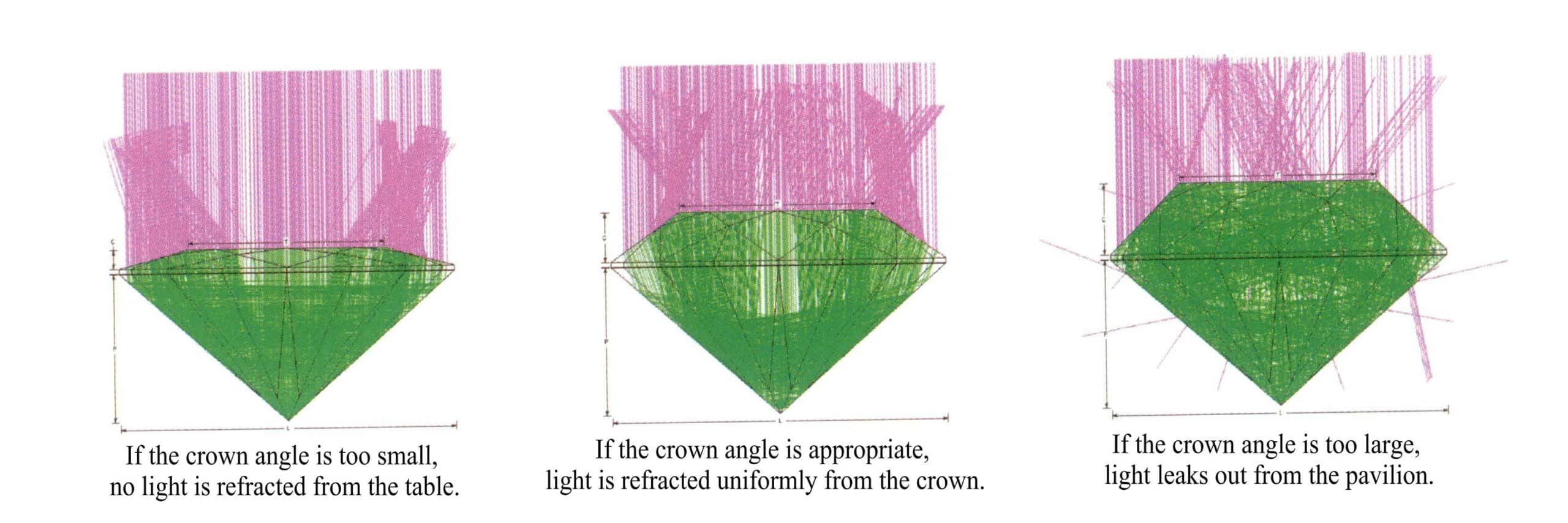
Therefore, the main factors affecting the total internal reflection of a gemstone are the pavilion angle and crown angle. In the design of gemstone cutting, the appropriate crown and pavilion angles should be calculated based on the refractive index of the gemstone material to achieve optimal brightness (Table 2-5).
Table 2-5 Gemstone refractive index and corresponding ranges of pavilion and crown angles
| Współczynnik załamania światła | Critical angle | Host's face angle | Crown's face angle |
|---|---|---|---|
| 1.40 ~ 1.60 | 45°36’ ~ 38°42’ | 43° ~ 45° | 40° ~ 45° |
| 1.60 ~ 1.80 | 38°42'〜33°42’ | 39° ~ 43° | 37° ~ 43° |
| 1.80 ~ 2.00 | 33°42'〜30° | 41° ~ 42° | 35° ~ 37° |
| > 2.00 | < 30° | 40° ~ 41° | 34° ~ 35° |
2. Fire
The fire of a gemstone refers to an optical phenomenon where faceted gemstones display flashes of spectral colors due to dispersion. From the gemstone’s characteristics, the fire is related to the dispersion value of the gemstone material; generally, the higher the dispersion value, the stronger the fire. It is also related to the gemstone’s color, transparency, etc. Deeply colored gemstones can obscure the presentation of fire, while gemstones with poor transparency can weaken it (Figure 2-39).

White light is refracted into the interior of the gemstone from the crown, and due to the different refractive indices of the spectral colors, after multiple reflections, the spectral colors are decomposed and finally refracted out from the crown, displaying fire. The fire of the gemstone is closely related to the crown angle; when the crown angle is larger, the fire is stronger, and when the crown angle is smaller, the fire is weaker (Figure 2-40).

Both fire and brightness are related to the total internal reflection of the gemstone. The brightness of the gemstone and fire are a pair of contradictions in the design of the gemstone cutting. In shapes, it is necessary to determine the appropriate cutting ratio based on the characteristics of the gemstone material to achieve the best balance between brightness and fire (Table 2-6).
Table 2-6 Suitable pavilion angles and crown angles for common gemstones
| Materiały z kamieni szlachetnych | Współczynnik załamania światła | Dyspersja | Critical angle | Pavilion Corner | Crown Corner |
|---|---|---|---|---|---|
| Diament | 2.417 | 0.044 | 24°26' | 41° | 33° |
| Syntetyczne cyrkonie sześcienne | 2.15 ~ 218 | 0.060 | 27°31' | 41° | 35° |
| Cyrkon | 1.810 ~ 1.984 | 0.038 | 32°02' | 41° | 35° |
| Granat | 1.710 ~ 1.940 | 0.022 ~ 0.028 | 35°05' | 42° | 37° |
| Korund | 1.762 ~ 1.770 | 0.018 | 34°37' | 42° | 37° |
| Chryzoberyl | 1.746 ~ 1.755 | 0.015 | 34°56' | 42° | 37° |
| Spinel | 1.718 | 0.020 | 35°36' | 42° | 37° |
| Peridot | 1.654 ~ 1.690 | 0.020 | 37°18' | 39° | 43° |
| Skaleń | 1.518 ~ 1.573 | 0.012 | 37°18' | 39° | 43° |
| Turmalin | 1.642 ~ 1.644 | 0.017 | 38°01' | 40° | 43° |
| Apatyt | 1.634 ~ 1.638 | 0.013 | 37°45' | 39° | 43° |
| Yellow topaz | 1.619 ~ 1.627 | 0.014 | 37°50' | 40° | 43° |
| Beryl | 1.577 ~ 1.583 | 0.014 | 39°13' | 42° | 42° |
| Kwarc | 1.544 ~ 1.553 | 0.013 | 40°20' | 43° | 42° |
Section VI Faceted Gemstone Cutting Design
There are no standard parameters for gemstone rough in the gemstone processing industry. The shapes of rough stones are varied and peculiar, which brings many problems to the subsequent gemstone processing. Especially in recent years, the rapid development of fully automatic gemstone machines in gemstone production has made the standardization of rough stones particularly prominent.
1. Design Cases of Round Cut Gemstones
(1) Design of Small-Sized Gemstones
Small-sized gemstones refer to those with a diameter of less than 2.5 mm. These gemstones are typically used as accent stones (satellite stones) in jewelry, complementing the main stone, so the design of these gemstones should be simple. Common designs for small gemstones are shown in Figure 2-41. The following three cuts are commonly used in the design of alloy jewelry.

(2) Design of Medium-Sized Gemstones
A round gemstone with a diameter of 3~8mm is a medium-sized gemstone, as shown in Figure 2-42.

(3) Design of large-sized gemstones
Gemstones with a diameter of more than 8 mm are considered large-sized gemstones. The larger the diameter of the large-sized gemstones, the more facets they have, but all facets are added at the crown, as shown in Figure 2-43.

(4) Design of other specifications of gemstones
① Hearts and Arrows.
The so-called Hearts and Arrows actually refer to brilliant-cut round gemstones. The main design principle is that the small facets below the crown correspond to the small ones above the crown and the main facets (all connections align). The angles must be just right so that the Hearts and Arrows can be seen under a lens with a specified focal length, as shown in Figure 2-44.
Hearts and Arrows is an optical imaging principle similar to the principles of Nine Hearts and One Flower and 16 Arrows and 16 Flowers discussed later.

② Nine heart of a flower Diamonds, 16 Arrows and 16 Flowers, as Figure 2-45 shows.

③ 11 Basic Round Shape, 13 Basic Round Shape.
The round shape we commonly see (bright shape) is based on the 8 version, which we call the 8 Basic Round Shape. The following cut types are 11 Basic Round Shape and 13 Basic Round Shape cut types (Figure 2-46, Figure 2-47).
Design Concept: When light refracts inside the gemstone, it refracts from one facet to the opposite facet, and two facets receive the incoming light, which exhibits better brightness than the effect of symmetrical facets.
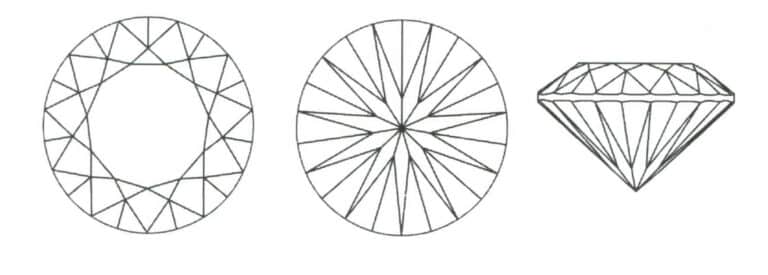
Figure 2-46 11 Basic Round Shape
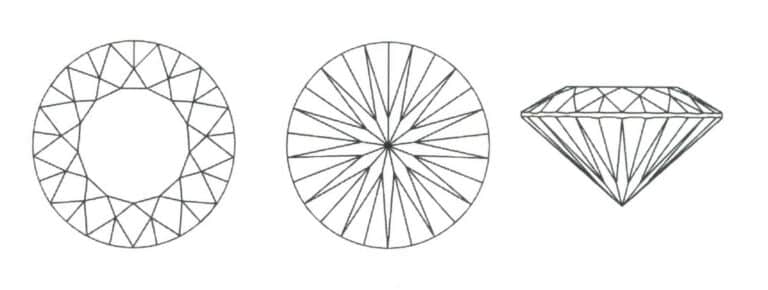
Figure 2-47 13 Basic Round Shape
④ Other round style designs.
Some gemstone materials are larger but relatively thin. If designed in the traditional cutting style, they would leak light and not achieve the desired effect. An ideal effect can be achieved by changing the crown’s cut during design to alter the light entering the gemstone (Figure 2-48).

2. Square cut gemstone design cases
(1) Small specification square cut
2.5 mm x 2.5 mm The following square is defined as a small specification square cut, which is mostly used as a side stone with relatively simple facets, as shown in Figure 2-49.

(2) Medium Specification Square Cut
The square of 3 mm × 3 mm ~ 7 mm × 7 mm belongs to the medium specification square cut (Figure 2-50). Its cut design is generally divided into three types: princess square, round pointed bottom, and parallel faceted. Among them, the princess square has a richer expression, the round pointed bottom has a more regular expression, and the parallel facet expresses classical and elegant styles.
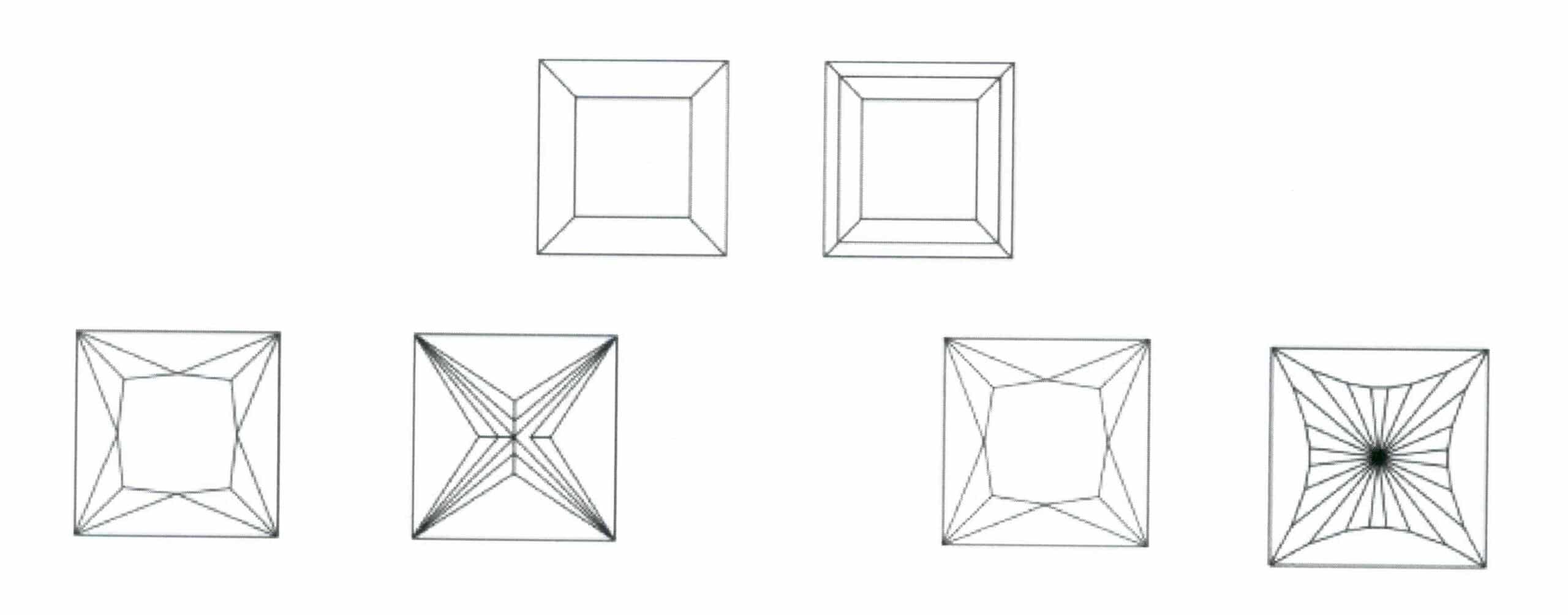
(3) Large Specification Square Style
The square larger than 8 mm×8mm belongs to the large specification square cut, and additional facets need to be added. There are two ways to add facets.
① Add a layer of small facets parallel to the waistline at the upper and lower parts (crown or pavilion), as shown in Figure 2-51.

② Add facets based on the existing structure, as Figure 2-52 shows. Because the gemstone is too large, the corresponding facets are also large, and adding facets can enrich the original cut and enhance the gemstone’s brilliance.

3. Design Cases of Elliptical Cut Gemstones
(1) Brilliant Cut Style
Gemstones with specifications below 8 mm x 8 mm are called brilliant cuts. The two common types of brilliant cuts are shown in Figure 2-53.

(2) Large Specification Elliptical Style
The specifications above 8 mm×10 mm are large oval cut shapes, as Figure 2-54 shows.
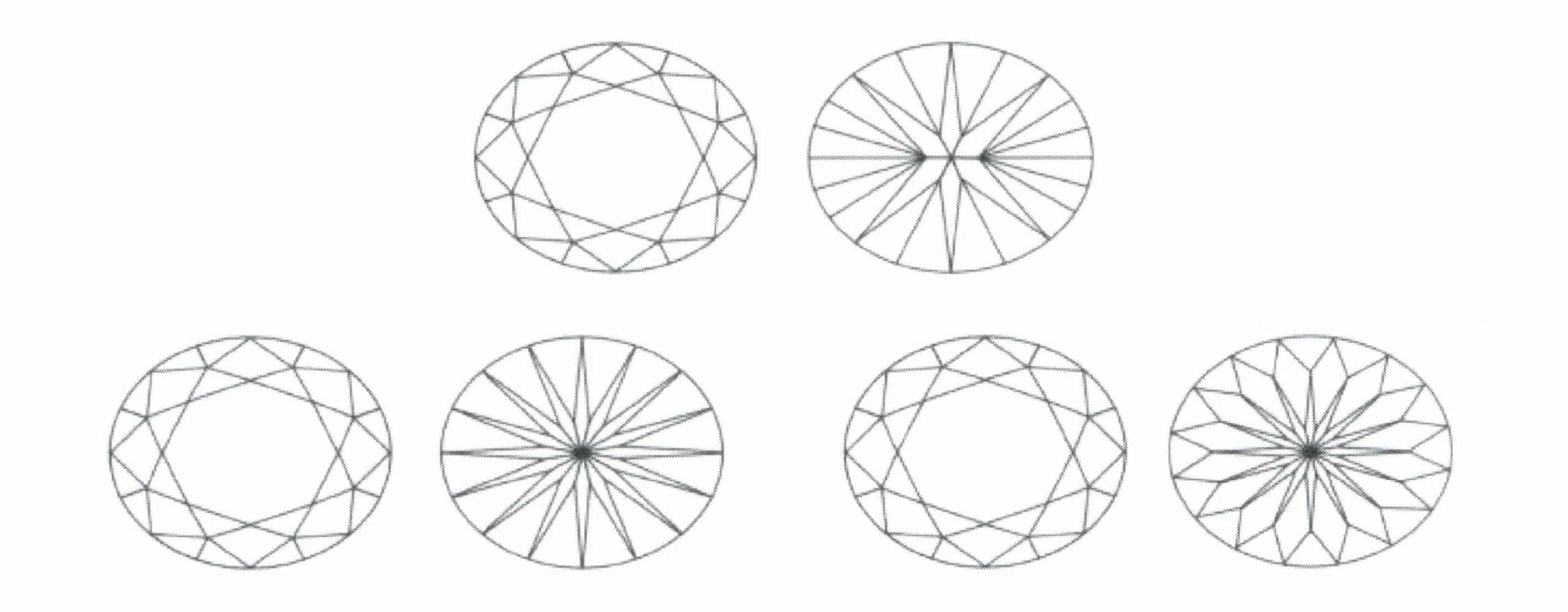
4. Design Cases of Marquise (Olive) Cut Gemstones
(1) Small Marquise Cut Shape
The cut shapes of 3 mm x 5 mm, 2 mm x 4 mm, 2.5 mm x 5 mm is a small marquise cut shape mostly used for accent stones in jewelry, as shown in Figure 2-55.

(2) Medium Specification Marquise Cut
The 3 mm x 6 mm ~ 4 mm x 8 mm is a medium specification marquise cut characterized by adding facets based on the small specification, as shown in Figure 2-56.

5. Pear-Shaped Cut Gemstone Design Case Studies
(1) Small specification pear-shaped cut
The cut type below 3 mm X 5 mm is the small specification pear-shaped cut, which is also used for auxiliary stones. The playful shape is shown in Figure 2-57.
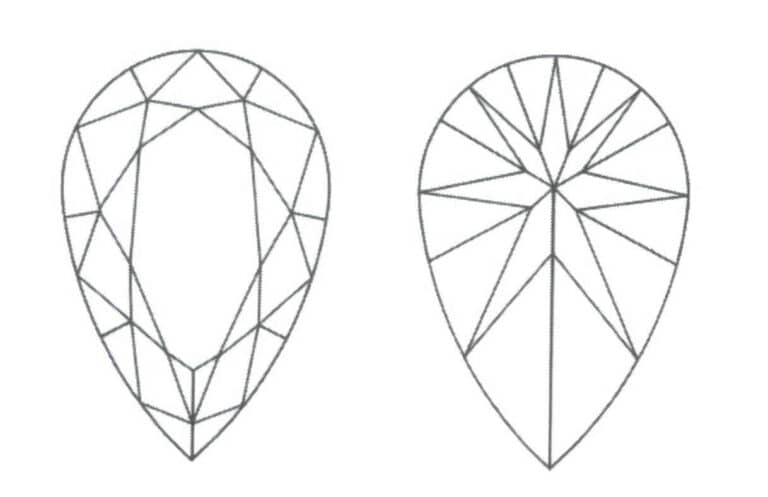
(2) Medium specification pear-shaped cut
The cut type above 4 mm x 6 mm is the medium specification pear-shaped cut, which adds facets based on the small specification. The number of facets depends on the size, and the variation is insignificant, as shown in Figure 2-58.
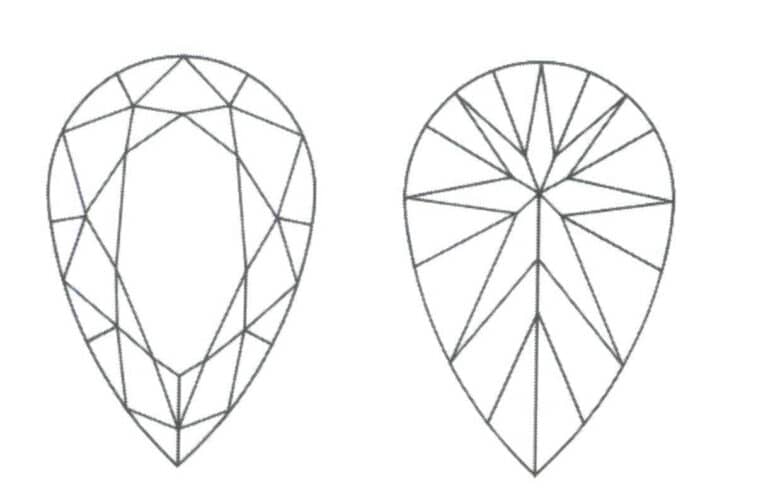
6. Heart Shape Cut Gemstone Design Case
The variation space for the heart shape cut is not large. To change it, refer to the pear-shaped cut and add facets at the non-main surface of the pavilion, as shown in Figure 2-59.

7. Rectangular Beveled Cut Gemstone Design Case
The emerald cut typifies the rectangular step cut, which displays a classical quality. The design of the rectangular step cut is similar to that of the square step cut, but the facets of the rectangle are more varied, as shown in Figure 2-60.
